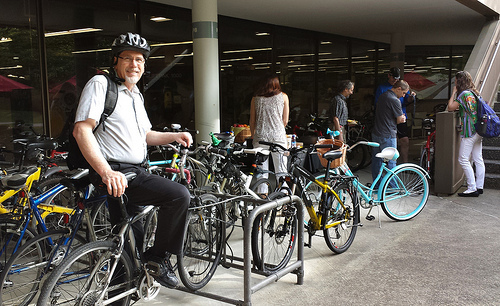How healthy is bike commuting? More than you might think.
An article in today’s Post Express says bike commuting is more dangerous than you’d think. That may or may not be true, but even if it is, it ignores years of studies that show the benefits outweigh the risks, and on the whole biking is statistically far more likely to adds years to your life than to harm you.
The article starts with an unsettling story about Inez Steigerwald, a teacher who has long commuted by bike (and who wrote about riding on the Metropolitan Branch Trail for Greater Greater Washington this time last year) hitting a patch of ice, falling off her bike, and breaking her arm very badly.
From there, author Sadie Dingfelder cites a 2007 study by the Centers for Disease Control that concluded that “nationwide, you’re more than twice as likely to die while riding a bike than riding in a car, per trip.” She adds that cyclists are about five hundred times as likely to die as the average bus passenger, and that a 2015 study concluded that cyclists inhale three times as much air pollution as drivers.
Payton Chung says the problem is that the article buries the lede by focusing on the pitfalls of riding a bike but not the benefits. “Bicycling and walking are healthful, moderate exercise that, on balance, add years to the average person’s life,” he says.
“Cycling is not inherently more dangerous than other modes of transportation,” adds Kelli Raboy. “It’s only more dangerous when you factor in the effect of cars. I think the article obfuscates this fact.”
Further discussion fleshed out Kelli’s point: Since a relatively small proportion of people use bikes for transportation, the number of injuries per trip are high. At the same time, there’s evidence to show that as more people ride bikes, the number of crashes goes down. That means that as more people ride bikes, the per trip metric will actually show that doing so is quite safe.
According to David Cranor, who wrote his own full response to Dingfelder’s article, stacking data about crashes and injuries for people riding bikes up against data about drivers makes for an apples to oranges comparison.
Comparing the average type of person is flawed, in part, because the population of motorists and cyclists differ so much. Cyclists are overwhelmingly more male and men are fatally injured 122% more often while cycling than motoring. In addition, there are many cyclists under 16 years old, but very few drivers of those ages.
In other words, the data presented here doesn’t tell you if YOU personally will be more at risk if you bike than drive. It tells you that the self-selected group of people who choose to bike are more at risk than a self-selected group of motorists.
Regarding the possibility of inhaling more pollution, Steve Seelig pointed toward a recent study that found the benefits of riding a bike (or walking) to drastically outweigh the negative impacts in terms of respiration.
“[Bike commuters inhale more pollution than drivers] on identical routes,” stresses Cranor. “If your bike ride takes you on the Capital Crescent or Mount Vernon Trails, that is almost surely untrue.”
And Dingfelder actually notes, later in the article, that “while injuries rob casual cyclists, age 18 to 64, of five to nine days of life and air pollution subtracts between one and 40 days, the benefits of cycling adds three to 14 months to your lifespan.” She also quotes a health researcher in Boston: “While accidents and air pollution pose serious risks, bike commuting is still the best choice for your overall health.”

